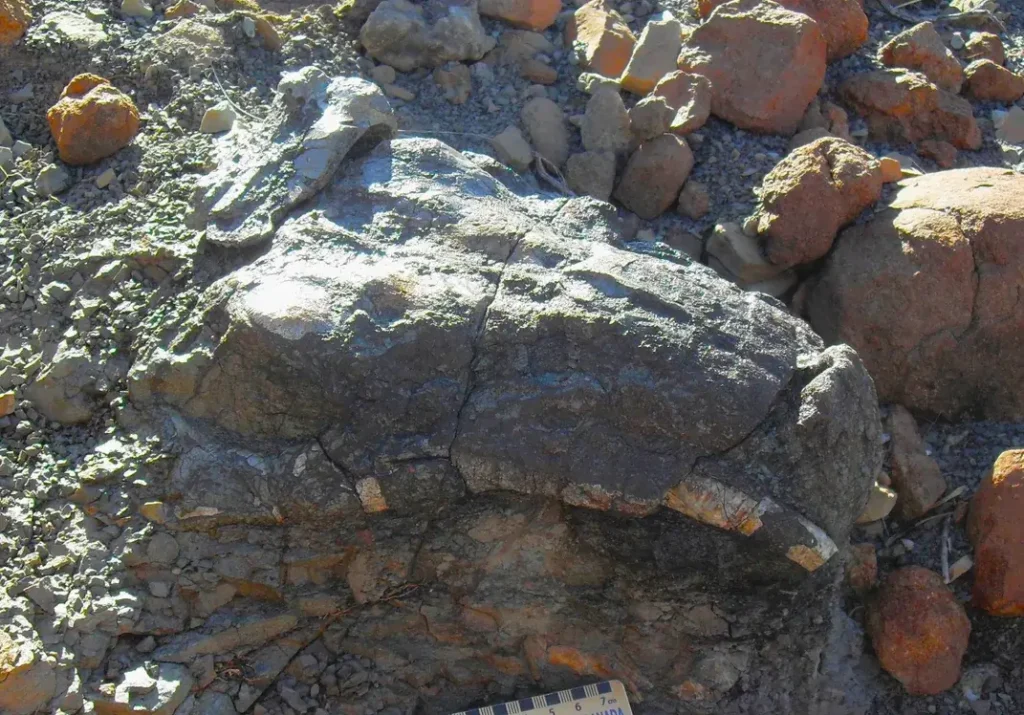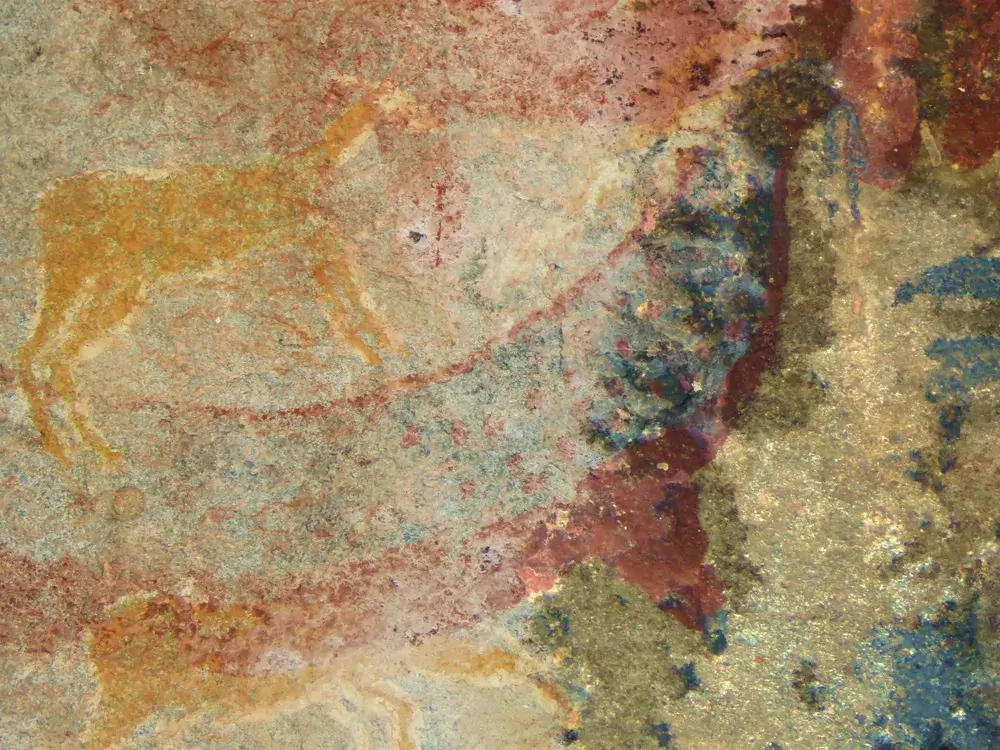In southern Africa, a 200-year-old rock painting found on a sandstone cliff called the “Horned Serpent Panel” has stirred excitement in the scientific community. Painted by the San people between 1821 and 1835, this artwork depicts a fascinating scene of warriors, spears, and familiar animals. Yet, there’s one creature in the painting that’s a total mystery: a long, curved body with tusks and polka-dotted skin.
Enter paleontologist Julien Benoit, who has suggested that this tusked figure might actually be a depiction of a dicynodont—an animal that went extinct around 200 million years ago. Yes, you read that right. This could be a representation of an extinct creature, painted by humans who lived long after it vanished from the Earth. So, what’s going on here? Could the San people have drawn inspiration from ancient fossils, and if so, what does that mean for our understanding of history?
Who Were the Dicynodonts?
Before diving into the potential fossil connection, let’s get one thing straight: dicynodonts were strange creatures. Ancestors of mammals, they walked the Earth alongside early dinosaurs and had a mix of bizarre features. Imagine a reptile-like body, a beak, and tusks. Yep, they sound like something from a sci-fi movie. These creatures went extinct around 250 million years ago, so obviously, no human ever saw them. But fossils of dicynodonts have been well-preserved in areas like South Africa’s Karoo Basin.
Could the San people have stumbled upon one of these fossils and used it as inspiration? Julien Benoit seems to think so. According to him, the painting’s tusks and dotted body resemble known dicynodont fossils.
How Did the San People Know About Dicynodonts?
Now, here’s where things get interesting. The San people, a hunter-gatherer culture, were known for their deep connection to their environment. They didn’t just paint for fun; their artwork often had spiritual or symbolic meaning, depicting their beliefs, ceremonies, and surroundings.
Benoit’s study, published in PLOS ONE, suggests that the San might have come across dicynodont fossils and incorporated them into their cultural practices. He notes that the area around the Horned Serpent Panel is rich in fossils, including dicynodonts, which supports his theory. And if he’s right, this would mean that the San people had paleontological knowledge long before Western scientists did.
The Science Behind the Claim
Let’s break it down a bit. Dicynodonts were first scientifically described by British scientist Richard Owen in 1845, based on fossils he found in South Africa. But the San painting was created at least a decade earlier, around 1835. If Benoit’s interpretation holds, this could mean that Indigenous people had already “discovered” the dicynodont through fossils long before Western science caught up.
This wouldn’t be the first time Indigenous knowledge outpaced Western science. In fact, Adrienne Mayor, a science historian at Stanford University, has pointed out that Indigenous cultures around the world often had detailed knowledge of prehistoric animals, which they incorporated into their belief systems. In the case of the San people, it seems entirely plausible that they recognized the ancient fossils as something worth documenting.
Myths, Rain-Making, and Fossils
But there’s more to the story. The San people had rich mythology surrounding large, mysterious animals, including creatures that they believed once roamed the land but disappeared. Could the dicynodont have been one of those creatures?
Benoit thinks so. He proposes that the San might have used the dicynodont’s image during rain-making ceremonies. According to San beliefs, during these ceremonies, shamans would enter a trance-like state and journey into the realm of the dead to bring rain back to the living world. By depicting an extinct creature, which they associated with the dead, they might have believed it had special power to bridge the gap between worlds and summon rain.
This theory, while speculative, adds an extra layer of depth to the story. If the San people did view the dicynodont as a symbolic creature, it’s possible they intentionally depicted it to tap into its spiritual significance.

What the Experts Think
Not everyone is fully convinced by Benoit’s theory, though. Some experts, like Kenneth Angielczyk, a paleobiologist from the Field Museum in Chicago, think it’s a fascinating idea but are cautious about jumping to conclusions. “As someone who loves dicynodonts,” he said in an interview, “I think it would be wonderful if people in the past noticed them in some way and incorporated them into their worldview.” But he also acknowledges that more evidence is needed to fully support this interpretation.
Other scientists are intrigued but wary of reading too much into the painting without further archaeological context. Still, the fact that such a hypothesis is even on the table shows just how interconnected history, art, and science can be.
What’s Next for This Discovery?
As the story of the Horned Serpent Panel continues to unfold, there’s a lot to learn from it. This painting might be one of the earliest depictions of paleontological knowledge in human history. It’s a reminder of the sophistication and environmental awareness that Indigenous cultures had long before modern science came into the picture.
So, what does this mean for us today? Well, for one, it challenges the assumption that Western science is the sole source of discovery and understanding. It also opens the door to more interdisciplinary research that bridges anthropology, archaeology, and paleontology.
For those intrigued by this discovery, there’s still so much left to explore. Could other rock art across the globe contain similar clues to prehistoric life? And what else might we learn from ancient cultures about their deep connection to the natural world?
If you’re fascinated by the intersection of history and science, keep an eye on new research from paleontologists like Benoit. And who knows—maybe the next big discovery will come not from a laboratory, but from an ancient painting on a rock wall.
A Piece of the Puzzle
The Horned Serpent Panel may just be one of many pieces in a much larger puzzle about humanity’s understanding of the world. Whether or not the creature in the painting is a dicynodont, the fact remains that the San people had an impressive grasp of their environment and its history. As we continue to uncover new discoveries, it’s worth remembering that ancient cultures often had wisdom that modern science is only just beginning to recognize.

